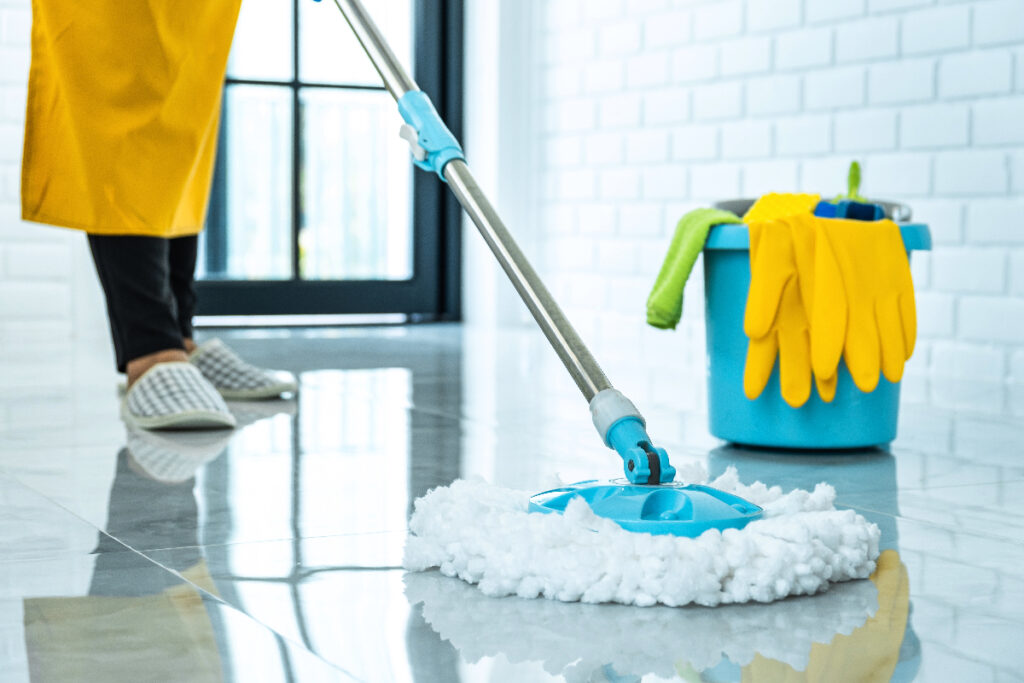
Cleaning is a common daily task that can cause back pain. Most specifically through vacuuming, cleaning windows, and mopping because you’re pulling and pushing your arm(s) back and forth which creates tension in your shoulders and back. Here are some tips to prevent back pain while cleaning:
- Vacuuming: When you’re vacuuming, try to keep your back straight. When vacuuming we tend to bend our spines a little and that leads to pain. Keep the vacuum in front of you and shift your weight from side to side.
- Cleaning windows: When cleaning the windows, try not to reach above your head to clean. If you need to reach up high, stand on a stool but make sure it’s secure.
- Mopping: When you fill the bucket to mop, don’t fill it with too much water because it will become heavy and put a strain on your arm and back. Put the bucket on a stool so you don’t have to bend your back to reach the bucket.
Cleaning is a daily task in most households. While it may seem like a simple chore, cleaning can cause back pain especially in the lower back. You might notice an aching back after vacuuming, mopping, or bending down repeatedly. If you’re wondering why your back hurts after cleaning, you’re not alone.
Let’s explore the causes, how certain cleaning habits strain your back, and what you can do to prevent it.
Why Cleaning Can Cause Back Pain
Cleaning often involves repetitive movements, awkward postures, and heavy lifting. All of these actions can put a lot of pressure on your spine and muscles.
Here are a few common reasons:
- Bending without support: Picking up items from the floor, reaching under furniture, or scrubbing low surfaces without bending your knees puts strain on your back.
- Twisting your torso: Repeated twisting while sweeping or vacuuming can stress the spine.
- Standing or kneeling for too long: These positions reduce circulation and fatigue your muscles.
- Using the wrong tools: Short-handled tools or heavy vacuums force you into bad posture.
These actions might not seem harmful in the moment, but over time, they lead to stiffness, soreness, and even long-term injury.
Lower Back Pain After Cleaning
Lower back pain after cleaning is especially common. This pain often happens due to muscle fatigue or strain on the lumbar spine. Your lower back supports most of your body weight during movement. When you bend, twist, or overreach while cleaning, the muscles in your lower back work overtime.
Other contributing factors include:
- Weak core muscles
- Poor body mechanics
- Overuse of muscles in one session
- Lifting heavy laundry baskets or mops
You may feel sharp pain, dull aches, or tightness in your lower back. These signs mean your back muscles are under stress and need rest or attention.
Why Does My Back Hurt After Cleaning?
If you’re wondering “Why does my back hurt after cleaning?” here’s a list of possible answers:
- Lack of stretching or warm-up: Cleaning is physical work. Doing it without preparing your body can lead to pulled muscles.
- Incorrect posture: Standing in a hunched position or bending from your waist increases the chance of back pain.
- Not taking breaks: Long cleaning sessions without rest can cause fatigue and overuse.
- Ignoring early signs of pain: Minor discomfort often turns into major pain when not addressed early.
Pain is your body’s way of telling you something is wrong. Don’t ignore it. Listen to your body and make small changes.
Why Does Vacuuming Hurt My Back?
Vacuuming may seem harmless, but it’s one of the top chores that cause back pain. Many people vacuum using just their arms, twisting and pushing the vacuum without moving their feet. This uneven movement strains your lower back and shoulders.
Other common vacuuming mistakes include:
- Bending forward instead of staying upright
- Using a vacuum that is too heavy or not adjustable
- Holding the vacuum in one hand and twisting the spine repeatedly
To avoid pain while vacuuming:
- Use a lightweight or self-propelled vacuum
- Keep your back straight and use your legs to move
- Avoid overreaching or twisting
- Switch hands often to avoid muscle imbalance
Tips to Avoid Back Pain While Cleaning
You don’t need to stop cleaning. You just need to clean smarter.
Here are practical ways to protect your back:
1. Warm-Up Before Cleaning
Stretch your back, shoulders, and legs for 5–10 minutes before starting any cleaning task.
2. Use Proper Body Mechanics
Bend your knees not your waist when picking things up. Engage your core when lifting or reaching.
3. Take Regular Breaks
Don’t clean the whole house in one go. Break tasks into shorter sessions with 10–15 minutes of rest in between.
4. Use Ergonomic Tools
Choose tools with long handles or adjustable heights to reduce bending.
5. Wear Supportive Footwear
Shoes with good arch support help absorb shock and protect your spine.
6. Switch Tasks Often
Alternate between standing, sitting, and moving to reduce pressure on one part of the body.
When to See a Doctor
If your back pain lasts longer than a few days, becomes severe, or limits your movement, consult a medical professional. Persistent back pain could signal an underlying issue like a herniated disc, sciatica, or muscle tear.
Final Thoughts
Cleaning can cause back pain, but with a few changes, you can reduce the risk. Pay attention to your posture, use proper tools, and take breaks. Prevention is the best approach when it comes to back health.
Your back supports everything you do. Take care of it even while cleaning.
Resource Link
For more expert tips and exercises to prevent cleaning-related back pain, visit:

